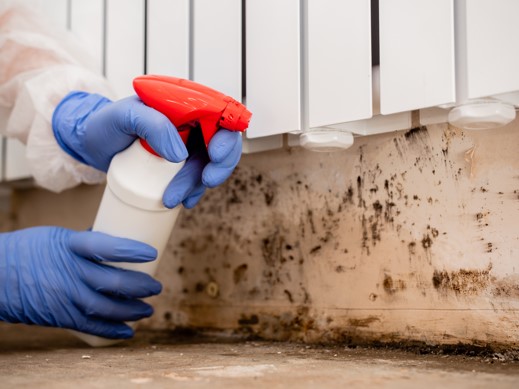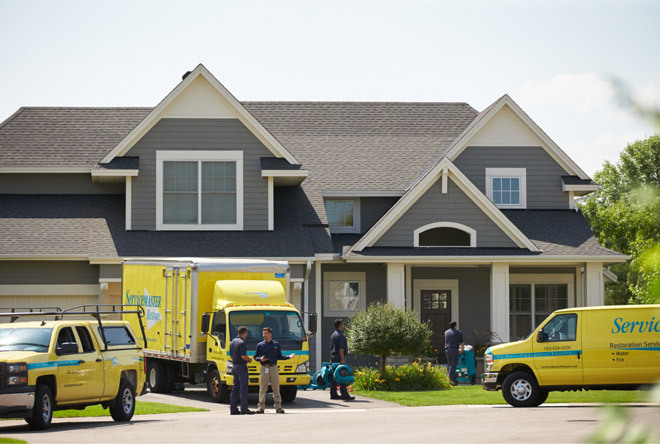West Plains Mold Removal & inspection
Residential Mold Remediation Services
While a natural part of life, mold continues to be one of the worst contaminants you can find on your property. Mold is a type of fungi that can grow indoors or outdoors – and it thrives in damp, warm, and humid environments. Not only does it pose a major health risk to you, your family, and anyone else that enters your space, it spreads and grows very easily under the right conditions. This is one of the many reasons why it’s important to call a team of mold damage restoration experts at the first sign of mold in your home.
At ServiceMaster of West Plains, our team is fully qualified and equipped with the best tools in the industry to handle any amount of mold exposure in any type of property you may own or manage. Depending on the severity of your mold infestation and damage, we’ll use our variety of time-tested methods and proven techniques to ensure your property is safe to enjoy once again by achieving safe and non-threatening mold levels.
On This Page:
- What Is Mold Remediation?
- How to Spot Mold
- Different Types of Mold
- How Fast Does Mold Grow?
- How to Prevent Mold
Looking for mold damage restoration in West Plains? Give our team a call at (417) 275-6993 or contact us online to request help from our team of trained restoration experts.
What Is Involved with Mold Remediation?

Simply put, mold remediation is the process of both removing mold and preventing its regrowth. Just removing mold won’t guarantee it will be gone for good. Some types of molds are capable of returning through spores in the air or through other means. The steps that come with the remediation process seek to deal with the types of molds that need more than just bleach or a good scrubbing, so that you can keep your space mold free for the years to come.
The actual mold remediation process will typically include:
- Cleaning the air
- Removal of mold
- Containment of the area
- Sanitizing the affected area
- An assessment of the mold type
Through our mold remediation services in West Plains, our team of experts can treat more severe cases of mold damage. Whether it has become rooted in your home’s studs or flooring, our mold remediation services use traditional reconstruction services to return your property to normal. This can include steps like sanding down wood, cutting away drywall, and more.
Ultimately, the service our team will perform depending on the severity of the mold growth, damage to your property, as well as the size of the area affected. Our ServiceMaster of West Plains team will present all of your options to ensure you’re making the best choice for your space.
How to Spot Mold
Mold tends to be dangerous not only to its hazardous effects but also due to its ability to go unseen for so long since it thrives in dark, secluded areas. But, when you understand some of the common signs of mold growth, you can have an easier chance of stopping growth before it becomes even bigger of a problem.
Some indicators of mold growth in your property include:
- Foul Odor – While not all molds give off an odor, many do. Any type of musty smell can be a sign of mold growth in your home and should be addressed by a professional right away.
- Visible Signs – While some molds might appear white and thread-like, others appear in clusters of small black spots. Mold also has a chance of being brown, black, gray, or green. If it is growing behind wallpaper, it might be orange, pink, or purple.
- Health Symptoms – If you are experiencing persistent coughing sneezing, congestion, or other cold-related symptoms while indoors, this may be a sign of mold growth in your home.
- Water Damage – Whether it was recent or a few months ago, any type of water damage, caused by flooding, plumbing leaks, or something similar, can lead to water damage if not cleaned up properly.
Beginning with a mold inspection of your West Plains property, our team will work to develop the best plan of action to help your property recover from mold and get back to normal. With every service we complete, you can rest assured that you’re going to be fine.
Not sure if there's a mold problem in your home? Just give us a call to schedule your mold inspection at(417) 275-6993 orreach out online!
What Different Types of Mold Can Grow In Your House?
Different types of mold are typically identified by their color. While mold can come in a wide variety of shades, the most common types found in homes include:
- Black Mold - This is the most common type of mold found in homes. It commonly grows in food or HVAC systems and can result in serious allergy symptoms in those living in the home.
- Green Mold - This is typically the same type of mold as black mold but has a different color. Other than the coloring, the characteristics are much the same.
- Orange or Red Mold - This type of mold isn’t found as commonly inside homes; it’s more common in outdoor areas. While harmless, you will likely want to have this type of mold removed to improve the overall appearance of your home.
- White Mold - Mold that is white in appearance is usually fresh and is still developing into the more harmful substance. This type of mold is usually easier to treat.
How Does Black Mold Form?
Black is the color that most concerns homeowners, with its reputation for toxic effects. As mentioned earlier, black molds are also the most common type spotted in residences. Understanding the origins and causes will help you reduce its presence and stay healthy.
Black mold typically grows under these conditions:
High humidity - Moreso than other types of mold, it likes very damp areas found after flooding, pipe bursts, and in poorly ventilated bathrooms.
Organic material - Paper is the preferred food for black mold, but it also grows well on drywall, cardboard, particleboard, wood, and straw.
Other conditions are necessary for growth, but not for survival. Mold can lay dormant until the right conditions emerge, which makes it difficult to kill off just by starving it of oxygen or light.
Mold spores are always present in the air, so what’s important to avoid growth is eliminating its preferred conditions.
How Fast Can Mold Grow from Water Damage?
Mold can begin to develop within as little as 48 hours from the first entrance of water into the home. As you can see, it’s important to eliminate the source of moisture, as well as completely dry the area and materials involved. If this isn’t done, mold will continue to grow.
How Can You Prevent Mold After Water Damage?
Even the smallest amount of water can trigger mold growth in your home if ignored. Additionally, if the water damage clean-up services aren’t completed as effectively as they should be, you can still have mold growth appear after some time.
To prevent mold growth after water damage, here are some things you should do:
- Eliminate Source of Water – First of all, after any type of water enters your property, be sure to eliminate the source of water. While it may be more difficult to do during a natural disaster compared to a plumbing leak, it’s important to reduce the amount of water entering your space via sandbags, sump pumps, or shutting off water valves.
- Remove Damaged Materials – While our team can take care of your home’s walls, flooding, and foundation, it’s important to begin removing damaged and wet items as soon as possible. This reduces the chance of mold growth in the home and gets your property on the trek back to normal.
- Dry the Area – Above all, it’s important to dry the area as best as possible. Even the smallest drop of moisture can activate mold, leading to a full-blown infestation. Any water that is left behind can seep into your home’s materials and lead to future problems if not cleaned up properly.
- Sanitize the Area – And lastly, it’s important to sanitize your area. This helps eliminate any bacteria that entered your property due to water damage, as well as reduces the possibility of mold popping up in your home.
At the first sign of trouble, give our team a call! With 24/7 emergency services, we’ll be there when other mold removal companies can’t be. Backed by a name with over 65 years of nationally renowned service, there’s no question why local homeowners continue to turn to ServiceMaster of West Plains for professional mold removal services to ensure the health and safety of themselves and their families.
Need mold remediation services now? Give our team a call 24/7 at (417) 275-6993 or contact us online!
```


